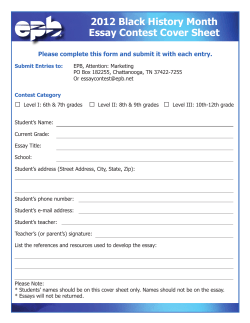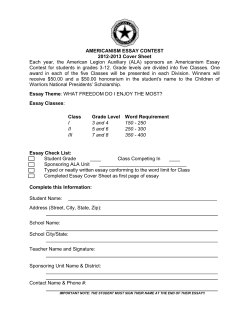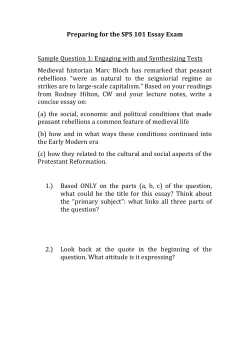
By Subject Area: Grade Level: 8th Grade GAIL DESLER,
n n n n n By GAIL DESLER, Elk Grove Unified School District Subject Area: Language Arts/Social Science/History Grade Level: 8th Grade Note: The lesson activity, reflection and extension pieces can be easily adapted to elementary and high school standards for U.S. History and English/Language Arts Standards: Listed at end of lesson In cooperation with the SACRAMENTO EDUCATIONAL CABLE CONSORTIUM ELK GROVE UNIFIED SCHOOL DISTRICT www.secctv.org www.egusd.net n n n n n OVERVIEW The interview clips in the documentary I’m American Too – A Story from behind the Fences (see link below) are short snippets from a much more complete collection of “living voices” archived in the Elk Grove Unified School District’s Time of Remembrance Oral Histories website. In limiting the documentary to 16 minutes, we provide students with a very brief overview of the “relocation” of thousands of citizens of Japanese heritage from the West Coast following President Roosevelt’s signing of Executive Order 9066. What our documentary does not include are the many chapters in the internment/incarceration story beyond the initial impact of forced removal of Japanese-Americans from their homes and communities. A longer version of the documentary would include stories of resilience, of resistance, of resettlement, of redress and — most importantly — of why it is so important to understand and to stand up for our constitutional rights — and for the constitutional rights of all citizens. This lesson is an invitation to students to help shed light on a historical event that is still not widely recognized as one of the worst constitutional violations in our nation’s history. Students will explore the internment experience through the first-hand accounts archived in the Time of Remembrance online collection. By stepping into the stories of selected internees (historical characters), they will demonstrate a sense of historical perspective and in the process, become experts on the internment experience and, hopefully, advocates for tolerance and social justice. OBJECTIVES Students will collect and evaluate information about the Japanese internment from Internet based oral histories. (CCSS Key Ideas and Details; Integration of Knowledge and Ideas) n Students will draw upon primary sources to create a presentation reflective of the Japanese internment experience. (CCSS Key Ideas and Details; Integration of Knowledge and Ideas) n Students will evaluate, analyze and reflect on the constitutional issues involved in the internment of Japanese Americans and make connections to current events. (CCSS Craft and Structure; Comprehension and Collaboration; Presentation of Knowledge and Ideas) n LESSON VIDEO LINKS n I’m American Too – A Story from behind the Fences http://www.secctv.org/video/?p=1415 n Time of Remembrance Oral Histories website http://www.egusd.net/tor/ Additional Resources: n A More Perfect Union from The Smithsonian http:// americanhistory.si.edu/perfectunion/experience/ index.html Life In A Japanese Internment Camp from The Smithsonian. http://americanhistory.si.edu/ourstory/activities/ n internment/ JARDA (Japanese American Relocation Digital Archives) From the Bancroft Library at UC Berkeley. n http://americanhistory.si.edu/ourstory/activities/ internment/ Generations of Japanese-Americans Scarred by WWII Internments from The Sacramento Bee. http://www. n sacbee.com/2012/02/19/4274670/a-pain-that-persists-generations.html Densho: Japanese American Legacy Project Non-profit organization with primary source materials on the World War II incarceration of Japanese Americans. n http://www.densho.org/ PROCEDURE Lesson Hook: Ask students to think about a time they lost something they cared about. The loss could be something that happened recently or in the past, but whatever they have lost, it is something they are likely to remember for a long time to come. Have them jot down their thoughts and then turn to the person next to them to share whatever they written about. Read aloud Yoshito Wayne Osaki’s short (four-paragraph story included at end of the lesson) My Dog Teny. Ask students to think about what were some of the losses the author experienced beyond the painful loss of his dog. Note: This short story is part of the From Our Side of the Fence – Growing Up in America’s Concentration Camps. Copies of the book are available through the Japanese Cultural and Community Center. http://jcccnc.org Begin the lesson: Depending on your school district, students may or may not have a background on the racism, discrimination, exclusion and forced removal experienced by thousands of Japanese-Americans during World War II. For a quick introduction or review, provide students with copies of Executive Order 9066. Show the documentary I’m American Too. Explain that the clips are gleaned from longer interviews housed on the Time of Remembrance website and that the students will have time to explore the archives as part of the lesson activity. Activity: Time of Remembrance Tableau A tableau is a frozen scene from a significant event in history or in a story. Characters in a tableau are frozen until an audience member taps on them. At that point they come to life and share their story – but as a monologue, not as a dialogue. Working in pairs or trios, students will pick one person included in the documentary. They will also bring in one interviewee from the Time of Remembrance Oral Histories Archive http://www.egusd.net/tor/archive.html whose interview is not included in the documentary. If working as a trio, they will include a third person, either from the documentary or the interview archive. They need to decide on an event which would bring their people together in the same setting (e.g., Saying good-bye to neighbors, arriving at camp, an in-camp experience, returning to their communities). and responsibilities in our physical communities, it does not address the growing need to be responsible digital citizens. In this essay, you have the option of including digital citizenship rights and responsibilities. A full credit essay will also include a connection you have made between events of the past and current events that either challenge or showcase the rights and responsibilities of citizenship. Depending on your classroom setup or availability of larger spaces at your site, such as the library of multipurpose room, have students present their tableaus one group at a time or as a gallery walk. ence the 2012 definition below, which includes “digital citizenship,” or incorporate your own. • Digital ID project http://digital-id.wikispaces.com Student Steps for Creating a Tableau Step 1: Decide on your characters. It is entirely reasonable to assume that their paths may have crossed before, during, of after the war years. Q Step 2: Storyboard the scene for your tableau. Label each character and include a paragraph that explains the tableau setting and event. You can step back in time to the war years or even draw from current events. n Step 3: Write monologue scripts for each character to introduce him/her to an audience. Your monologue should include: • Your character’s name and place of birth • Background on your character: What was his/her life like before the scene you have chosen for your tableau? • The historical context of the scene: “Context” is the “setting.” For an event, for example, your scene would provide the audience with some insight into the attitudes and political and economic conditions going on during the event you have chosen. • What is actually happening in the scene • Your character’s thoughts and feelings about the event you’re acting out n Step 4: Create a simple backdrop for your setting. n Step 5: Rehearse your tableau. Be sure to practice staying in your frozen position until all team members have spoken. Q Reflection Piece Citizenship: What does it mean to you? Debrief the tableau activity. Ask how the internment story connects to issues of citizenship. Show the Citizen Me PowerPoint http://www.icivics.org/teachers/lesson-plans/ citizen-me. Invite student input on samples of positive citizenship within their community. Writing prompt: Write a reflective essay to explain what citizenship means to you. Be sure to include both your rights and your responsibilities. Although the above PowerPoint does an excellent job of explaining rights Definition for citizenship: You are welcome to refer- As upstanding Citizens, we need to participate positively in our physical communities - our schools, neighborhoods, cities, states, countries and the world. Likewise, as exemplary Digital Citizens, we must learn how to participate positively in a variety of digital/cyber/online communities. It is only by developing a clear sense of both our rights and our responsibilities that we can become fully engaged and contributing Citizens of all the communities in which we find ourselves. • Bernasconi & Desler, 2012 For our purposes, we define digital |dijitl| (adjective) as of, relating to, or characteristic of electronic information and media, including computers, the Internet and cellular networks and other mobile technologies. We define citizen |sitizn; -sn| (noun) as a participating and contributing member of a community, with certain citizen’s rights and responsibilities. Extension Taking citizenship beyond the classroom When students have completed their reflective essays, ask them to highlight their favorite sentences or phrases. Using a voice recording program, such as Audacity, VoiceThread or PhotoStory, invite students to create a shared online essay by adding what they’ve selected from their essays. NPR’s This I Believe http://www.npr.org/ series/4538138/this-i-believe has wonderful samples to illustrate the power of the human voice. The program is based on a 1950s radio program of the same name and features Americans from all walks of life sharing the personal philosophies and core values that guide their daily lives. You might want to have students use the This I Believe format for their audiocasts to create a product such as this one created by high school students in Michigan. http://digitalis.nwp.org/resource/524 ASSESSMENT Scoring Guide for Tableau (Total possible points = 60)* Criteria Points Earned Team Points Process: team members worked well together, with everyone contributing to the assignment, staying on task and making good use of all class time. (10) /10 Product: The tableau scene was historically accurate and well-rehearsed, with each member staying true to their character’s story. (10) /10 Written Monologue: Writing is clear and concise, historically accurate and shows insight into the character, vocabulary and event. (20) /20 Delivery: Stayed true to character’s attitude, feelings and emotions; spoke part clearly and expressively. Made eye contact with audience. (20) /20 /60 Individual Points Total Points Earned *Note: Scoring guide adapted from Read, Write, Think’s rubric for reflective essay http://www.readwritethink.org/files/resources/lesson_images/lesson963/Rubric.pdf Scoring Guide for Reflective Essay (Total possible points = 100)* Criteria Points Earned Team Points Depth of Reflection: Essay demonstrates thorough and thoughtful understanding of the writing prompt and subject matter. (25) /25 Use of Textual Evidence and Historical Content: Used specific and relevant examples from the interview clips and any supporting text, making insightful connections between events of the past and present. (25) /25 Language Use: Writing is clear, concise and engaging, with a sense of voice, an awareness of audience and purpose and varied sentence structure. (25) /25 Conventions: Writing shows understanding of conventions, with few, if any, errors that distract readers from the message. (25) /25 /100 Total Points Earned *Note: Scoring guide adapted from Fahrenheit 451 lesson by Adrianna Reyes (MERIT 2011). STANDARDS ADDRESSED Common Core State Standards: English Language Arts, History Social Studies (Grades 6-8) Key Ideas and Details RH.6-8.1. Cite specific textual evidence to support analysis of primary and secondary sources. RH.6-8.2. Determine the central ideas or information of a primary or secondary source; provide an accurate summary of the source distinct from prior knowledge or opinions. n RH.6-8.3. Identify key steps in a text’s description of a process related to history/social studies (e.g., how a bill becomes law, how interest rates are raised or lowered). n n Craft and Structure RH.6-8.4. Determine the meaning of words and phrases as they are used in a text, including vocabulary specific to domains related to history/social studies. n RH.6-8.5. Describe how a text presents information (e.g., sequentially, comparatively, causally). n RH.6-8.6. Identify aspects of a text that reveal an author’s point of view or purpose (e.g., loaded language, inclusion or avoidance of particular facts). n Integration of Knowledge and Ideas n RH.6-8.7. Integrate visual information (e.g., in charts, graphs, photographs, videos, or maps) with other information in print and digital texts. n RH.6-8.8. Distinguish among fact, opinion and reasoned judgment in a text. n RH.6-8.9. Analyze the relationship between a primary and secondary source on the same topic. Common Core State Standards: English Language Arts, Speaking and Listening (Grade 8) Comprehension and Collaboration SL.8.1. Engage effectively in a range of collaborative discussions (one-on-one, in groups and teacher-led) with diverse partners on grade 8 topics, texts and issues, building on others’ ideas and expressing their own clearly. • Come to discussions prepared, having read or researched material under study; explicitly draw on that preparation by referring to evidence on the topic, text, or issue to probe and reflect on ideas under discussion. • Follow rules for collegial discussions and decision-making, track progress toward specific goals and deadlines and define individual roles as needed. • Pose questions that connect the ideas of several speakers and respond to others’ questions and comments with relevant evidence, observations and ideas. • Acknowledge new information expressed by others and, when warranted, qualify or justify their own views in light of the evidence presented. n SL.8.2. Analyze the purpose of information presented in diverse media and formats (e.g., visually, quantitatively, orally) and evaluate the motives (e.g., social, commercial, political) behind its presentation. n SL.8.3. Delineate a speaker’s argument and specific claims, evaluating the soundness of the reasoning and relevance and sufficiency of the evidence and identifying when irrelevant evidence is introduced. Presentation of Knowledge and Ideas n SL.8.4. Present claims and findings, emphasizing salient points in a focused, coherent manner with relevant evidence, sound valid reasoning and well-chosen details; use appropriate eye contact, adequate volume and clear pronunciation. Q SL.8.5. Integrate multimedia and visual displays into presentations to clarify information, strengthen claims and evidence and add interest. Q SL.8.6. Adapt speech to a variety of contexts and tasks, demonstrating command of formal English when indicated or appropriate. n ISTE NETS for Students (Grades 6-8) 3. Gather data, examine patterns and apply information for decision making using digital tools and resources. (1,4) 4. Participate in a cooperative learning project in an online learning community. (2) 5. Evaluate digital resources to determine the credibility of the author and publisher and the timeliness and accuracy of the content. (3) Note: The numbers in the parentheses after each item identify the standards (1–6) most closely linked to the activity described. Each activity may relate to one indicator, to multiple indicators, or to the overall standards referenced: 1. Creativity and Innovation 2. Communication and Collaboration 3. Research and Information Fluency 4. Critical Thinking, Problem Solving and Decision Making 5. Digital Citizenship 6. Technology Operations and Concepts n n n n n his favorite food: rice and meat with gravy. Somehow he knew that he would be left behind. The day before our departure, he disappeared. I searched everywhere, calling his name, but I could not find him. MY DOG “TENY” by Yoshito Wayne Oaski One day my father brought home a puppy and I named him “Teny.” He was like a fuzzy ball, with light tan fur on his back and short white fur underneath. He was my constant companion. When I came home from school, he was always there waiting for me, wagging his tail and jumping all over me. When I played harmonica, he sat by me and accompanied me with his off-key howl. He was always with me when I went fishing, hunting, or just for a walk. He was just a mutt, but to me he was the cutest dog in the whole wide world. He was my best friend. When the Evacuation Order came in late May of 1942, we were told no pets were allowed in camp. Who would take care of my Teny after we were gone? Who would feed him? Who would be willing to take care of a “Jap” dog? We had no choice but to leave him behind. A few days before we were to leave for camp, he looked so sad all day long. He would not even eat Finally the day came and we loaded our duffel bags and suitcases into the back of the truck. I climbed on top of the baggage to look for Teny, still hoping to see him for the last time. As the truck started to speed up, Teny suddenly leaped out of nowhere and chased us. After about a mile, he became tired and started to fall behind. Finally he stopped and sat down in the middle of the road, panting heavily. Tears filled my eyes and I could no longer see my Teny. Note: My Dog Teny is a short story from the book From Our Side of the Fence – Growing Up in America’s Concentration Camps, edited by Brian Komai Dempster and published by the Japanese Cultural and Community Center of Northern California. www.jcccnc.org Permission to copy and distribute this single story for educational purposes and to accompany the I’m American Too lesson and documentary was granted by the publisher. n n n n n
© Copyright 2025





















